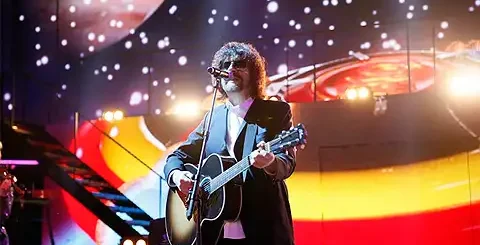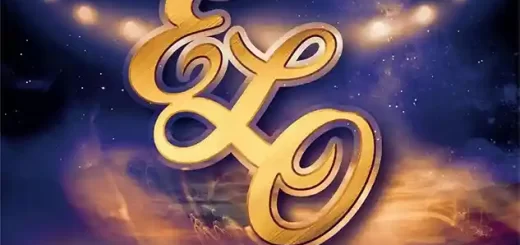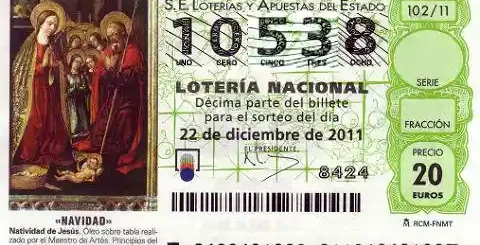BREVE ENTREVISTA EXCLUSIVA de RICHARD TANDY & DAVE MORGAN para ELO ESPAÑA
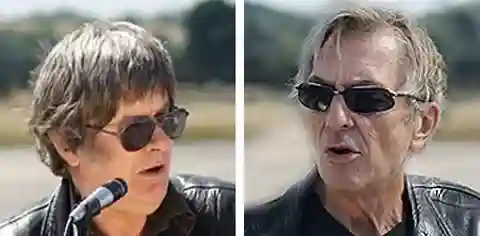
Podemos decir que lo que incluimos a continuación es lo más importante que nos ha podido pasar en los 12 años que tenemos abierta esta web en internet.
Con la inestimable ayuda de GED EASTICK,
«ELO ESPAÑA» ha realizado
una BREVE ENTREVISTA EXCLUSIVA
a RICHARD TANDY y DAVE MORGAN
LA ENTREVISTA a continuación de los merecidos agradecimientos.
En primer lugar, desde ELO ESPAÑA, nuestro agradecimiento y gratitud a RICHARD TANDY y DAVE MORGAN, por su disposición, por permitirnos realizarles unas preguntas y por responder aquellas que consideraron oportunas.
Por supuesto a GED EASTICK, sin cuya ayuda nada de esto hubiese sido posible. Él fue quién nos facilitó el poder realizar la entrevista y el mediador entre ELO ESPAÑA y TANDY & MORGAN. Muchas gracias por tu amabilidad y ayuda GED.
También a quienes aportaron la mayor parte de las preguntas para completar esta entrevista, ellos son: PEDRO LÓPEZ y MAURI MARTÍNEZ (Old Future Crash). Éstos propusieron las preguntas más interesantes, muchas de las cuales no respondieron.
Y como no, a aquellas personas que han colaborado con nosotros en la transcripción y traducción del material recibido. Gracias a IVÁN FERNÁNDEZ ÁLVAREZ, MAGDALENA TECLES y LENNY. Su trabajo fue crucial para que hoy lo podamos incluir aquí. Somos conscientes de la dificultad que entraña este trabajo extraído de un fichero en audio.
Nuestra satisfacción es inmensa y consideramos un logro el haber estado en el lugar y en el momento más adecuado para que ésto fuese posible.
El audio comienza con una corta frase en español pronunciada por TANDY & MORGAN al unísono: «UNO, DOS, TRES… HOLA JOSÉ, ¿cómo está?»… sobran las palabras…
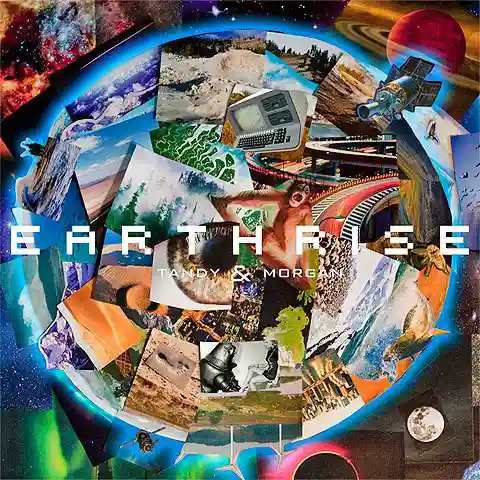
ENTREVISTA EXCLUSIVA de RICHARD TANDY & DAVE MORGAN para ELO ESPAÑA
ELOSP: ¿Cómo nace la idea de editar el disco EARTHRISE?
DM: «Bueno pues muy duro. Yo vi una foto en una revista, una revista americana, Life, en las navidades de 1986, era una foto polaroid tomada desde una ventanilla del apolo 8 en la que se veía la tierra ascendiendo por encima del horizonte de la superficie de la luna. Vi la imagen y el texto que decía: picture from a earthrise taken (imagen de nuestro planeta «amaneciendo»), y esa palabra y la imagen simplemente me parecieron mágicas. Una imagen de ese tipo es única. Así fue».
ELOSP: En temas como por ejemplo «Pictures On My Pilow» se evidencia vuestra pasión por las voces procesadas con vocoder que tan de moda están hoy en día en la música dance… ¿creéis que fuisteis pioneros en este aspecto? ¿las voces para el vocoder son solo tuyas o también son de Richard?
RT: «Pues más o menos… (risas)… Bueno, en realidad fue Jeff con «Mr. Blue Sky», tuvo el primero en 1976… esa fue la primera canción grabada con vocoder. El vocoder al principio era una máquina muy complicada, el teclado y las voces iban por separado, pero pronto avanzaron las cosas y salieron mejores vocoders en los que el micrófono estaba incluído a la máquina, lo que resultaba más sencillo para trabajar con las voces robóticas… salía uno nuevo cada mes… Pioneros sí, pero… ciertamente el mejor trabajo fue hecho por Dave».
ELOSP: Seguro que RICHARD fue imprescindible en el proyecto EARTHRISE ¿crees que ELO hubiese sonado igual con otros teclados?
GE: Bueno, ayúdenme a interpretar esta pregunta: va sobre el sonido grabado de ELO, ¿Cuándo tomasteis la decisión consciente de que los álbumes no sonasen de la misma forma que ELO? ¿O lo hicisteis por algún motivo?
DM: «Creo que hay una doble negación ahí, y no, no lo hicimos. Se puede apreciar la conexión familiar, pero Jeff y yo mismo amamos a los Beatles, toda nuestra música tiene influencia Beatle… todos íbamos en la misma dirección musicalmente hablando, muy melódica y con mucha armonía, y yo amo todo eso, y Jeff también ama todo eso… no teníamos la intención de sonar como ELO, pero no me sorprende que el estilo se parezca».
ELOSP: ¿Estáis al tanto de los avances tecnológicos de hoy en día?
RT: «No».
ELOSP: Algunos grupos actuales como los franceses AIR o M83 valoran a ELO / Richard Tandy como influyentes para su sonido Retro-sintético… ¿Qué pensáis de estos grupos y de la música electrónica actual?
RT: «Bueno, la verdad es que no lo sé, no he escuchado mucho de ellos. Yo fui un afortunado en los tiempos en que los teclados electrónicos salieron, me gustaba mucho el minimoog, era un simple sintetizador monofónico (sintetizadores pequeños)… Cuando estos fueron mejorando cada vez más con más aplicaciones todo se volvió más una locura. Había una época en la que salía uno casi cada mes. Todos tenían un sonido particular, yo tenía un KORG syntetiser, tenía un sonido fabuloso que no podíamos conseguir con nada más, era como una máquina del tiempo… «3rd planet» fue creado por entero con un secuenciador. Creo que pasábamos muchos sonidos a través del vocoder como el bajo o el finger guitar. El bajo sólo tenía un tono muy grave y al pasarlo a través del vocoder y del secuenciador lo que salía al final era un sonido totalmente distinto y electrónico».
GE: Esta es una pregunta que quería haceros y es porque he estado hablando con varias personas que trabajan con teclados electrónicos. Vosotros fuisteis la primera generación que los usó, nunca tuvisteis un maestro ni alguien que os dijera como hacerlo precisamente por ser los primeros.
DM: Existía un brillante libro de instrucciones.
GE: Así que veis o podéis ver este material electrónico como una vía o una manera de que la gente aprenda a tocar antes o de que le sea más fácil tocar, ¿cómo empezó todo antes de que esto se convirtiera en parte de la industria?
DM: «Bueno, creo que ahora los cambios son más rápidos y las cosas se pueden hacer más rápidamente. Puedes comprar cualquier aparato nuevo y usarlo. La gran cantidad de dispositivos facilita la frescura y la aparición de novedades… Antes no tenías nada de esto pero creao que gracias a que Richard estaba en ELO y ELO se había convertido en algo tan grande e importante en el mundo de la música muchos fabricantes estaban contentos y dispuestos a dejarnos probar sus máquinas y eso hacíamos. Con ellas tocábamos y las probábamos, incluso podíamos valorarlas y querían que las publicitáramos».
GE: Y finalmente, en una isla desierta, si pudierais elegir un instrumento para llevar ¿Cuál elegirías?
RT: «Un gran piano definitivamente».
DM: «Yo me llevaría mejor una guitarra, porque la podría usar como remo estando sentado en el gran piano de Tandy».
RT: «Como el piano lleva muchas teclas se podría hacer señales de fuego. Espéranos, llegamos en dos semanas a casa ahahhahaa…».
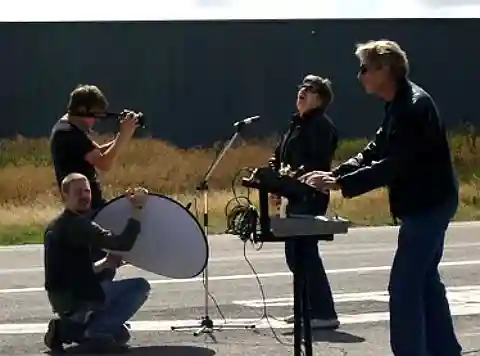
Como experiencia consideramos una aventura el propósito que emprendimos y en el que pusimos todo nuestro empeño y el tiempo necesario para culminarlo, recompensado por el resultado de ese trabajo. En pocas palabras: «Mereció la pena el esfuerzo». ¡Ojalá podamos repetirlo! Éste será un referente para otras posibles oportunidades que se nos presenten en el futuro.
ELOSPAIN:
We can say that what we include below is the most important thing that has happened to us in the 12 years that we have had this website open on the Internet.
With the invaluable help of GED EASTICK,"ELO ESPAÑA" has made
A BRIEF EXCLUSIVE INTERVIEW
to RICHARD TANDY and DAVE MORGAN
THE INTERVIEW below the well-deserved thanks.
First of all, from ELO ESPAÑA, our thanks and gratitude to RICHARD TANDY and DAVE MORGAN, for their willingness, for allowing us to ask them some questions and for answering those they considered appropriate.
Of course to GED EASTICK, without whose help none of this would have been possible. He was the one who facilitated the interview for us and was the mediator between ELO ESPAÑA and TANDY & MORGAN. Thank you very much for your kindness and help GED.
Also to those who contributed most of the questions to complete this interview, they are: PEDRO LÓPEZ and MAURI MARTÍNEZ (Old Future Crash). These proposed the most interesting questions,many of whom did not respond.
And of course, to those people who have collaborated with us in the transcription and translation of the material received. Thanks to IVÁN FERNÁNDEZ ÁLVAREZ, MAGDALENA TECLES and LENNY. His work was crucial so that we can include it here today. We are aware of the difficulty involved in this work extracted from an audio file.
Our satisfaction is immense and we consider it an achievement to have been in the most appropriate place and time to make this possible.
The audio begins with a short phrase in Spanish pronounced by TANDY & MORGAN in unison: "ONE, TWO, THREE… HELLO JOSÉ, how are you?"… there are not enough words…
EXCLUSIVE INTERVIEW by RICHARD TANDY & DAVE MORGAN for ELO ESPAÑA
ELOSP: How did the idea of releasing the album EARTHRISE come about?
DM: "Well, very hard. I saw a photo in a magazine, an American magazine, Life, at Christmas 1986, it was a Polaroid photo taken from a window of Apollo 8 in which the earth could be seen rising above the horizon of the surface of the moon. I saw the image and the text that said: picture from an earthrise taken, and that word and the image just seemed magical to me. An image like that is unique . That's how it went".
ELOSP: In songs such as "Pictures On My Pilow" your passion for vocoder-processed voices that are so fashionable today in dance music is evident… do you think you were pioneers in this aspect? Are the voices for the vocoder just yours or are they also Richard's?
RT: "Well, more or less… (laughs)… Well, actually it was Jeff with "Mr. Blue Sky", had the first in1976… that was the first song recorded with a vocoder. The vocoder at first was a very complicated machine, the keyboard and the voices were separate, but things soon progressed and better vocoders came out in which the microphone was included in the machine, which was easier to work with robotic voices. … a new one came out every month… Pioneers yes, but… certainly the best work was done by Dave."
ELOSP: Surely RICHARD was essential in the EARTHRISE project. Do you think ELO would have sounded the same with other keyboards?
GE: Well, help me interpret this question: it's about the recorded sound of ELO. When did you make the conscious decision that the albums would not sound the same as ELO? Or did you do it for some reason?
DM: "I think there's a double negative there, and no, we didn't. You can see the family connection, but Jeff and I love the Beatles ourselves, all our music has a Beatle influence… we were all in the same boat."direction musically speaking, very melodic and with a lot of harmony, and I love all that, and Jeff loves all that too… we didn't intend to sound like ELO, but I'm not surprised that the style is similar."
ELOSP: Are you aware of today's technological advances?RT: "No."
ELOSP: Some current groups such as the French AIR or M83 value ELO / Richard Tandy as influential for their Retro-synthetic sound… What do you think of these groups and current electronic music?
RT: "Well, the truth is that I don't know, I haven't heard much about them. I was lucky in the days when electronic keyboards came out, I really liked the minimoog, it was a simple monophonic synthesizer (small synthesizers). .. When these got better and better with more applications everything became more crazy. There was a time when one came out almost every month. They all had a particular sound, I had a KORG synthesizer, it had a fabulous sound that we couldn't With nothing else, it was like a time machine… "3rd Planet" was created entirely with a sequencer. I think we ran a lot of sounds through the vocoder like bass or finger guitar. The bass just had a very deep tone. bass and passing it through the vocoder and sequencer makes itthat came out at the end was a totally different and electronic sound".
GE: This is a question I wanted to ask you and it's because I've been talking to several people who work with electronic keyboards. You were the first generation to use them, you never had a teacher or someone to tell you how to do it precisely because you were the first.
DM: There was a brilliant instruction book.
GE: So you see or can see this electronic stuff as an avenue or a way for people to learn to play sooner or to make it easier for them to play, how did it all start before this became part of the industry?
DM: "Well, I think that now the changes are faster and things can be done more quickly. You can buy any new device and use it. The large number of devices makes it easier to be fresh and new… Before you had nothing about this but I think that thanks to Richard being in ELO and ELO had become something so big andImportantly in the world of music, many manufacturers were happy and willing to let us try their machines and that's what we did. We played with them and tried them, we could even evaluate them and they wanted us to advertise them."
GE: And finally, on a desert island, if you could choose one instrument to carry, which one would you choose?
RT: "Definitely a great piano."
DM: "I'd take a guitar better, because I could use it as a paddle while sitting at Tandy's grand piano."RT: "Since the piano has many keys, it could make fire signals. Wait for us, we will be home in two weeks ahahhaha…".

